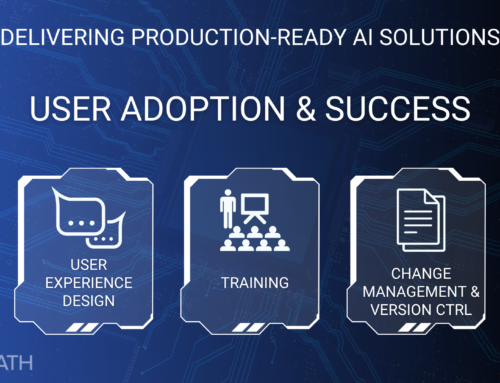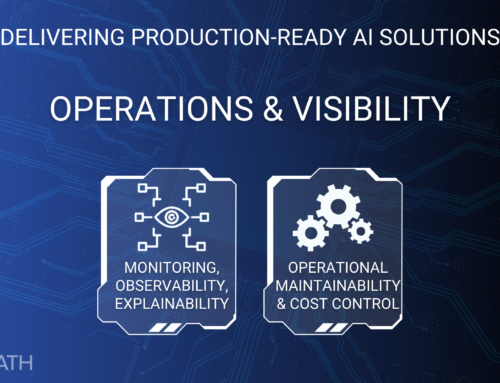Your AI system works perfectly. The models are accurate, the interface is intuitive, and the demonstrations are impressive. Leadership is excited about the possibilities. Then comes the moment of truth: making it work with everything else.
Here's where most AI projects hit the wall. Not because the AI technology fails, but because nobody planned for the reality that businesses don't operate in isolation. Your AI needs to work with customer databases built in 2003, accounting systems that were state-of-the-art in 2010, and workflow management tools that were implemented last year by different departments with different priorities.
Integration challenges don't just slow down AI deployment. They often make impressive technology completely unusable for actual business operations.
The Integration Reality That Surprises Everyone
AI vendors demonstrate their technology in clean, controlled environments. The AI system has direct access to well-formatted data. User interactions happen through dedicated interfaces. Everything works together because everything was designed to work together.
Your business operates differently. Customer information lives in multiple systems that don't always agree with each other. Sales teams use different tools than customer service teams. Financial data gets processed through one system while operational metrics track through another. Information that should be connected often isn't, and data that should be synchronized frequently lags behind real-time business needs.
This creates a gap that most organizations underestimate: the effort required to make AI systems work smoothly within complex business ecosystems often exceeds the effort needed to build the AI functionality itself.
Think of it like installing a sophisticated sound system in a car. The speakers might be top-quality and the amplifier might be powerful, but if you can't connect them to the car's electrical system, integrate with the dashboard controls, and route wiring through existing pathways, you end up with expensive equipment that doesn't actually improve your driving experience.
AI integration works the same way. The technology might be sophisticated, but business value only emerges when AI capabilities enhance existing workflows rather than requiring people to work around integration limitations.
For this reason, CtiPath developed the Production-Ready AI Solutions Framework. The third part of that framework is System Integration & Reliability.
The Three Pillars of AI That Actually Works in Business
Successfully deploying AI in complex business environments requires systematic attention to three interconnected elements that determine whether AI enhances or disrupts business operations.
Element 8: Integration Architecture – Making AI Play Well with Others
Integration architecture ensures that AI systems connect seamlessly with existing business applications while enhancing rather than disrupting established workflows.
API design that matches business processes creates interfaces that align with how people actually work rather than how AI systems prefer to operate. Your customer service AI shouldn't require agents to switch between multiple applications to access customer history, current issues, and resolution options.
Data synchronization that maintains consistency ensures that information stays current across all systems without creating conflicts or gaps. When your sales team updates customer information, your AI-powered marketing system needs to reflect those changes immediately, not discover them during the next batch update.
Workflow integration that feels natural enables people to access AI capabilities through existing business processes rather than learning entirely new procedures. Financial analysts shouldn't need to export data, upload it to an AI system, and then import results back into their reporting tools.
Enterprise system compatibility addresses the reality that businesses run on diverse technology stacks with different update cycles, security requirements, and operational constraints. Your AI needs to work with systems that can't be easily modified or replaced.
The key insight: successful AI integration treats existing business systems as valuable assets to enhance rather than obstacles to work around. This approach creates sustainable value because it builds on established workflows rather than forcing organizational change to accommodate technology limitations.
Element 9: Resilience and Fault Tolerance – When Things Go Wrong (And They Will)
Resilience ensures that AI systems continue delivering business value even when components fail, dependencies become unavailable, or unexpected conditions arise.
Graceful degradation under stress enables AI systems to maintain core functionality when perfect operation isn't possible. Your customer recommendation engine might switch to simpler algorithms when advanced AI services experience issues, providing somewhat less sophisticated suggestions rather than no suggestions at all.
Intelligent fallback strategies provide alternative approaches when primary AI capabilities fail. If your document analysis AI encounters technical problems, the system routes documents to human reviewers rather than creating processing bottlenecks that affect business operations.
Dependency management that reduces single points of failure protects business operations when external services, data sources, or computational resources experience problems. Your financial analysis AI works with multiple data providers and can switch between different model providers if necessary.
Recovery procedures that minimize business impact ensure that AI system failures don't cascade into broader operational disruptions. When problems occur, affected processes have clear escalation paths and alternative procedures that maintain business continuity.
Monitoring that predicts problems before they cause outages identifies potential issues early enough to take preventive action. Performance degradation, capacity limitations, and dependency problems get addressed before they affect user experience or business operations.
Resilience isn't about preventing all failures—it's about ensuring that inevitable failures don't compromise business operations or create expensive recovery situations.
Element 10: Disaster Recovery – Preparing for When Everything Goes Wrong
Disaster recovery protects business operations when worst-case scenarios occur: major system failures, security incidents, data corruption, or infrastructure outages that affect AI-dependent processes.
Backup strategies that cover AI-specific assets protect not just data but also model artifacts, configuration settings, training datasets, and the complex dependencies that enable AI functionality. Traditional backup approaches often miss critical AI components that are expensive to recreate.
Recovery procedures that restore business capability focus on resuming operations rather than just restoring technology. Your AI-powered customer service needs alternative procedures that maintain service levels while technical systems recover.
Business continuity planning that accounts for AI dependencies ensures that critical processes can continue operating when AI systems aren't available. Manual procedures, alternative systems, and temporary workarounds protect business operations during extended recovery periods.
Testing that validates recovery under realistic conditions verifies that disaster recovery procedures actually work under pressure. Recovery scenarios should include realistic timelines, resource constraints, and coordination challenges that characterize actual emergency situations.
Geographic distribution that protects against regional disasters deploys AI capabilities across multiple locations to ensure business continuity when local infrastructure failures or natural disasters affect primary systems.
The goal isn't just recovering AI functionality; it's maintaining business operations with minimal disruption even when AI systems face catastrophic failures.
How Integration and Reliability Create Competitive Advantage
Organizations that invest properly in integration architecture and reliability capabilities experience fundamentally different AI deployment outcomes than those that focus purely on AI technology.
Seamless integration enables widespread adoption because AI capabilities enhance existing work patterns rather than requiring people to learn new systems or change established procedures. Users embrace AI tools that make their jobs easier, not those that complicate familiar workflows.
Robust reliability builds organizational confidence in AI capabilities, enabling deployment in business-critical processes where less reliable systems would be too risky to use. This confidence allows organizations to pursue ambitious AI applications that create significant competitive advantages.
Comprehensive disaster recovery protects AI investments by ensuring that expensive AI development efforts aren't lost when technical problems occur. Organizations can invest confidently in AI capabilities knowing that technical failures won't compromise business operations or require starting over.
Proven resilience reduces operational overhead because AI systems handle routine problems automatically rather than requiring constant manual intervention. Operations teams can focus on optimization and expansion rather than firefighting integration issues and system failures.
Most importantly, strong integration and reliability capabilities enable AI to become integral to business operations rather than remaining isolated technology that provides limited value despite sophisticated capabilities.
Questions That Reveal Integration and Reliability Readiness
When evaluating AI initiatives, these questions reveal whether integration and reliability concerns are properly addressed:
Integration Architecture: How does the AI system connect with existing business applications? What happens when those applications change or get updated? How do users access AI capabilities within their normal workflows rather than through separate interfaces?
Resilience and Fault Tolerance: What happens when AI services experience problems or become unavailable? How does the system handle unexpected data or usage patterns? What alternative approaches maintain business operations when AI capabilities aren't working perfectly?
Disaster Recovery: How quickly can AI functionality be restored after major failures? What procedures maintain business operations during extended recovery periods? How do you protect the AI-specific assets and configurations that enable system functionality?
Detailed answers that address real-world complexity and business impact suggest mature approaches to integration and reliability. Technical responses that focus on AI capabilities without considering business workflow integration indicate gaps that will create adoption and operational challenges.
The Infrastructure Investment That Enables AI Success
Building robust integration and reliability capabilities requires more upfront planning than deploying standalone AI systems. But this investment creates sustainable business value:
Faster user adoption because AI capabilities integrate naturally with established work patterns rather than requiring organizational change to accommodate technology limitations.
Higher business impact because AI systems can be deployed in mission-critical processes where integration problems or reliability issues would be unacceptable.
Lower operational costs because resilient systems require less manual intervention and disaster recovery capabilities protect AI investments from expensive failure scenarios.
Organizational confidence in AI capabilities that enables ambitious applications and enterprise-wide deployment rather than limiting AI to low-risk pilot projects.
Competitive differentiation through AI capabilities that can be deployed reliably in customer-facing and business-critical applications where competitors struggle with integration challenges.
Building AI That Works in the Real World
The AI transformation is real, but capturing its benefits requires systems designed for the complexity of real business environments rather than the simplicity of isolated demonstrations.
Organizations that treat integration architecture and reliability as core requirements position themselves to deploy AI confidently across their enterprise. Those that assume impressive AI technology will automatically work well with existing business systems often discover expensive integration challenges that limit AI value or prevent deployment entirely.
Your business systems aren't perfect, and they don't need to be. But AI systems built with proper integration and reliability foundations can deliver sustained business value despite the inevitable complexity and occasional failures that characterize real business operations.
The question isn't whether your business systems are ready for AI. It's whether your AI approach is ready for your business systems.





